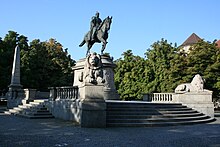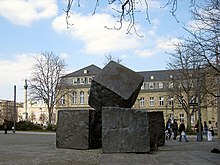Karlsplatz (Stuttgart)
The Karlsplatz is a historic square in the center of Baden-Wuerttemberg state capital Stuttgart .
Localization
The square is lined in the north by the Old Palace and in the east by the western front of the New Palace . To the south of the square, the corner building of the old orphanage at Charlottenplatz, and to the west, the newly created Dorotheen Quartier, adjoins Karlsplatz. The square is enclosed in an atrium-like manner by rows of chestnut trees, two rows on the long sides and three rows on the narrow sides. In the center of the square is the equestrian monument of Emperor Wilhelm I, King of Prussia and German Emperor .
History of the place
In 1393 the place of today's Karlsplatz was first mentioned as a private garden of the Duchess . This walled garden was attached to the old castle and was reserved for the wife of the ruling prince. Initially this was Countess Antonia Visconti , wife of Count Eberhard III. (des Mild) von Württemberg, whose peace-keeping policy of alliances with the neighboring royal houses and imperial cities earned him the nickname.
In 1556 a garden house was built in the middle of the garden on the site of today's Wilhelm I monument.
In 1778, Duke Karl Eugen had the Duchess' garden, now neglected, removed in the course of relocating his official residence from Ludwigsburg to Stuttgart in order to level the property and convert it into a public promenade. The new facility was popularly known as Planie (from planieren), a name that has persisted to the present day, especially since the access road to the city center above the city tunnel is also called today. Inspired by the absolutist charm of representative garden architecture, the Duke, known for his late reign as a connoisseur and despot, laid out the square with a symmetrical system of paths, equipped with lawns, benches, flower beds and a fountain. After the Duke's death in 1793, the square was named Karlsplatz.
In 1795, instead of the fountain, Karlsplatz was given a 10 m high marble obelisk , the so-called “pyramid”. For the first time, Karlsplatz was transformed into a memorial square. Due to constant damage, the obelisk had to be demolished again in 1807. A water basin was built in its place. In 1841 the water basin was turned into a fountain in the shape of a water-spouting juggler.
The equestrian monument
In 1898 the Kaiser Wilhelm Monument was erected in place of the fountain, an equestrian statue in honor of Wilhelm I, King of Prussia and German Emperor. The memorial committee under the honorary presidency of the crown prince and later (at the same time last) king of Württemberg, Wilhelm II , quickly agreed that the deceased emperor deserved an equestrian memorial based on the Roman imperial era. This was unveiled on October 1 of the year after the honorary bearer had died ten years earlier, on March 9, 1888.
The memorial was created as a design by the Munich professors Wilhelm von Rümann (1850–1906) and Friedrich Ritter von Thiersch (1852–1921). Before the final destination of Karlsplatz as the installation site for the equestrian statue, the architect and sculptor arranged a demonstration on the spot with painted canvases in the original size of the statue. After the visit failed to the satisfaction of King Wilhelm II, he agreed to the choice of location.
The sculptor Rümann created the equestrian statue and Thiersch, who was in turn an architect, designed the pedestal of the statue as well as the granite, massive and sweeping terrace substructure along with three outside staircases, the frontal execution of which is adorned by two resting lions. In the style of its own tradition and Egyptian building elements, granite obelisks were placed in the rear area. Wilhelm I as the unifier of the empire is shown here in the monument in close connection with war and unification of the empire.
Criticism of the equestrian monument
In the following years, the square seems to have suffered from its claim to great power, as there was originally lawn around the monument and diagonal paths leading to the center of the square. With the elimination of these park attributes - today the area is paved with cobblestones - the area around the square lost its center.
Multiple efforts to relocate the imperial monument have so far failed. In 1945, Arnulf Klett , the city's first mayor after the war, wanted a Freedom Square without a monument. Transfer intentions were revived in the 1980s and again in the late 1990s. This time for political, sometimes for economic reasons. The inner courtyard of the former Rotebühl barracks (today the seat of the OFD and tax office departments) was already being considered as a future home . Change requests for the place have not died down to this day.
Karlsplatz in the years 1928–1978
Starting in 1928, Karlsplatz developed into the city's market center for the next 30 years. The lawn gave way to a fortified square that made it possible to hold a wholesale market for vegetables and (southern) fruits. With the opening of the wholesale market on the Neckar, the pulsating market life died down.
From 1937 until the end of the war, the headquarters of the Gestapo Stuttgart was located in the Hotel Silber , from here the deportation of the Württemberg Jews was organized.
Due to the traffic calming in 1957, the Karlsplatz itself became a parking lot in the absence of a parking garage. With the demolition of the High Karlsschule in 1959, the area around Karlsplatz had lost its attractiveness. More than 20 years later, an underground car park on Konrad-Adenauer-Straße had been built, and parking was finally banned from Karlsplatz.
In 1970 the city of Stuttgart had the memorial for the victims of National Socialism erected on Karlsplatz opposite the Old Palace to mark the 25th anniversary of the post-war era . It is an ensemble of four black granite blocks - as a symbol of the severity of the Nazi era - by the Oggelshausen sculptor Elmar Daucher . The memorial bears an epigram by the German philosopher Ernst Bloch .
Karlsplatz since the 1980s
After the new construction of Karlsplatz in 1980, large parts of the partly two-row chestnut tree population come from the Kastanienallee leading to Solitude , which was thinned out for this purpose.
There is a flea market on Saturdays . This has existed since 1983. In May and September, the “large flea markets” extend from Karlsplatz right into the city center.
Once a year, the Hamburg fish market takes place on the square . The Stuttgart Wine Village also takes place in Hamburg as part of a cultural exchange .
In the 1990s, the Bündnis 90 / Die Grünen party proposed that Karlsplatz be renamed Clara-Zetkin -Platz.
The Da Vinci project was launched in 2008 on the initiative of the state of Baden-Württemberg and the Breuninger department store . In 2011, new state ministries, a luxury hotel, shops and restaurants, the so-called Da Vinci area, were to be built from Karlsplatz in a south-westerly direction . This was to be a complex between the market hall , the already existing Breuninger area and Hauptstätter Straße . The building of the Hotel Silber , which was repaired after the war and was Gestapo headquarters from 1937 to 1944 , should have given way to the new buildings . The city of Stuttgart planned to set up a Nazi memorial and a place of learning, and various initiatives wanted to preserve the entire building.
In 2011, after the state government changed, the state withdrew from the Da Vinci project. The Breuninger company now pursued the development of the area alone. The project was renamed Dorotheen Quartier. The plan for a luxury hotel was abandoned. The Hotel Silber was also preserved. The development plan was approved in 2013. On the upper floors, the state contractually secured office space for ministries. The opening took place in 2017.
See also
- List of Kaiser Wilhelm I monuments
- List of monuments in Stuttgart
- Schloßplatz (Stuttgart) (diagonally opposite)
- Charlottenplatz (Stuttgart) (up the plane 2 minutes)
literature
- Friedemann Schmoll : Eternal nation, studies on the culture of remembrance of the empire and individual state in the Württemberg monument cult of the 19th century. Stuttgart 1995.
- Chronicle of the capital and residence city of Stuttgart 1898. Stuttgart 1899.
- Konrad Dreher : tear-off calendar of my life. Munich 1929.
- Franz Herre: Kaiser Wilhelm, the last Prussian. Cologne 1980.
- Werner Skrentny, Rolf Schwenker, Sybille Weitz, Ulrich Weitz: Stuttgart on foot . Silberburg-Verlag, ISBN 978-3-87407-813-9 .
Web links
Individual evidence
- ↑ Photo series
- ↑ #Dreher 1929 , pp. 62–63.
- ↑ there: footnote 42 "On the anniversary: Kaiser im Gerede" in the Stuttgarter Zeitung of July 2, 1998
- ^ Stuttgart: Several thousand participants in May demonstrations
- ↑ dealing with controversies
- ^ Hermann Lenz, Stuttgart: Portrait of a city
- ↑ The flea market with a heart
- ↑ Hamburg's fish market as a guest in Stuttgart
- ↑ The Stuttgart Wine Village (information) on: stuttgarter-weindorf.de
- ↑ Da Vinci Project ( Memento from August 31, 2010 in the Internet Archive )
- ↑ New ministries as a gateway to the city center ( Memento from October 8, 2009 in the Internet Archive )
- ↑ The horror cannot be torn away - Stuttgarter Nachrichten ( Memento from September 28, 2008 in the Internet Archive )
- ^ City of Stuttgart: Development plan Dorotheen Quartier. Retrieved January 2, 2019 .
Coordinates: 48 ° 46 ′ 35.5 " N , 9 ° 10 ′ 51.5" E




